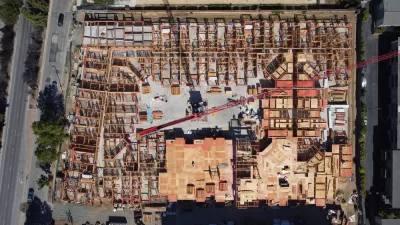Despite a few high-profile failures, the California State Legislature has approved a steady drumbeat of pro-development reforms that loosen zoning restrictions. The state raised the stakes on its zoning reforms this week.

California Governor Gavin Newsom signed senate bills 8, 9, and 10, and Assembly Bill 1174, into law this week—each intended to spur the creation of more housing supply by loosening zoning restrictions. The California State Legislature approved SB 9 and SB 10 late in August, but the governor's signature waited until the conclusion of a recall vote which ultimately ended in his favor.
The California State Legislature has provided a battleground for housing and zoning policy reform for several years now, with SB 9 attracting most of the attention of forces on either side of the issue in the 2021 legislative session. According to a statement released by Gov. Newsom's office to announce the signing of the bills, the California Housing Opportunity and More Efficiency (HOME) Act (SB 9) "facilitates the process for homeowners to build a duplex or split their current residential lot, expanding housing options for people of all incomes that will create more opportunities for homeowners to add units on their existing properties."
Proponents of the bill are calling the governor's action the end of single-family zoning in California (although some would argue that the statewide legalization of accessory dwelling units in 2016 had the same effect). Regardless of where one draws the line, California now undisputedly joins Oregon as the two state's making the most aggressive use of state preemption to override local zoning laws to reverse the racist roots of exclusionary zoning and, potentially, provide more affordable housing options for residents.
As for SB 10, the press release provides this explanation:
SB 10 by Senator Scott Wiener (D-San Francisco) creates a voluntary process for local governments to access a streamlined zoning process for new multi-unit housing near transit or in urban infill areas, with up to 10 units per parcel. The legislation simplifies the CEQA requirements for upzoning, giving local leaders another tool to voluntarily increase density and provide affordable rental opportunities to more Californians.
Senator Scott Wiener, of course, authored some of the state's previous, failed attempts at dramatic overhauls of the planning and zoning status quo in the name of a supply side approach to the state's housing affordability crisis, SB 827 and SB 50.
SB 8, authored by State Senator Nancy Skinner (D-Berkeley), "extends the provisions of the Housing Crisis Act of 2019 (SB 330) through 2030. The Housing Crisis Act of 2019, which was scheduled to expire in 2025, accelerates the approval process for housing projects, curtails local governments’ ability to downzone and limits fee increases on housing applications, among other key accountability provisions."
Also receiving a mention in the press release is AB 1174, by Assemblymember Tim Grayson (D-Concord), "an urgency measure that makes changes to the existing streamlined, ministerial approval process for housing development in jurisdictions that have not yet made enough progress towards their allocation of their regional housing needs." The Regional Housing Needs Assessment process, underway right now throughout the state, is proving continuously controversial and contentious.
California YIMBY, a leading proponent of the state's recent pro-development legislation, also put out a press release celebrating the final approval of the four bills, saying the bills will "significantly advance the goal of increasing housing affordability and availability throughout the state, especially in urban areas and near transit." Livable California, the high-profile group on the other side of the issue, was calling for the governor to veto the bills up until the 11th hour.
FULL STORY: Governor Newsom Signs Historic Legislation to Boost California’s Housing Supply and Fight the Housing Crisis

Alabama: Trump Terminates Settlements for Black Communities Harmed By Raw Sewage
Trump deemed the landmark civil rights agreement “illegal DEI and environmental justice policy.”

Planetizen Federal Action Tracker
A weekly monitor of how Trump’s orders and actions are impacting planners and planning in America.

The 120 Year Old Tiny Home Villages That Sheltered San Francisco’s Earthquake Refugees
More than a century ago, San Francisco mobilized to house thousands of residents displaced by the 1906 earthquake. Could their strategy offer a model for the present?

In Both Crashes and Crime, Public Transportation is Far Safer than Driving
Contrary to popular assumptions, public transportation has far lower crash and crime rates than automobile travel. For safer communities, improve and encourage transit travel.

Report: Zoning Reforms Should Complement Nashville’s Ambitious Transit Plan
Without reform, restrictive zoning codes will limit the impact of the city’s planned transit expansion and could exclude some of the residents who depend on transit the most.

Judge Orders Release of Frozen IRA, IIJA Funding
The decision is a victory for environmental groups who charged that freezing funds for critical infrastructure and disaster response programs caused “real and irreparable harm” to communities.
Urban Design for Planners 1: Software Tools
This six-course series explores essential urban design concepts using open source software and equips planners with the tools they need to participate fully in the urban design process.
Planning for Universal Design
Learn the tools for implementing Universal Design in planning regulations.
Clanton & Associates, Inc.
Jessamine County Fiscal Court
Institute for Housing and Urban Development Studies (IHS)
City of Grandview
Harvard GSD Executive Education
Toledo-Lucas County Plan Commissions
Salt Lake City
NYU Wagner Graduate School of Public Service





























